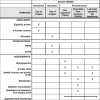Anaesthetist-controlled versus patient-maintained effect-site targeted propofol sedation during elective primary lower-limb arthroplasty performed under spinal anaesthesia (ACCEPTS): study protocol for a parallel-group randomised comparison trial
- PMID: 30760311
- PMCID: PMC6374891
- DOI: 10.1186/s13063-019-3228-4
Anaesthetist-controlled versus patient-maintained effect-site targeted propofol sedation during elective primary lower-limb arthroplasty performed under spinal anaesthesia (ACCEPTS): study protocol for a parallel-group randomised comparison trial
Abstract
Background: The clinical efficacy of effect-site targeted patient-maintained propofol sedation (PMPS) compared to anaesthetist-controlled propofol sedation (ACPS) for patients undergoing awake joint replacement surgery is currently unknown. There is no commercially available medical device capable of delivering PMPS so we have designed and built such a device. We plan a clinical trial to compare PMPS to ACPS and to collect data relating to the safety of our prototype device in delivering sedation.
Methods: The trial is an open-label, randomised, controlled superiority trial recruiting adults who are undergoing elective primary lower-limb arthroplasty with sedation by propofol infusion by effect-site targeting into two equal-sized parallel arms: PMPS and ACPS. The primary research objective is to compare the body-weight-normalised rate of propofol consumption when sedation for surgery on adults undergoing elective primary lower-limb arthroplasty under spinal anaesthesia is patient-maintained versus when it is anaesthetist-controlled. The study primary null hypothesis is that there is no difference in the rate of propofol consumption when sedation is patient-maintained versus anaesthetist-controlled.
Discussion: This is the first trial to test the superiority of effect-site-targeted patient-maintained propofol sedation versus anaesthetist-controlled propofol sedation in terms of total propofol consumption during the sedation period. The results of this trial will help inform clinicians and device manufacturers of the clinical efficacy and safety of patient-maintained propofol sedation applied to a common operative setting.
Trial registration: International Standard Randomised Controlled Trial Number Registry, ISRCTN29129799 . Prospectively registered on 12 June 2018.
Keywords: Joint arthroplasty; Patient-maintained propofol sedation; Procedural sedation; Propofol sedation; Regional anaesthesia.
Conflict of interest statement
Ethics approval and consent to participate
Informed written consent will be obtained from all study participants. This protocol was granted authorisation by Wales Research Ethics Committee 6 on 3 September 2018 (Reference 18/WA/0190), by the UK Medicines and Healthcare products Regulatory Agency on 21 August 2018 (Reference CI/2018/0035) and by the UK Health Research Authority on 7 September 2018 (Reference 231,688).
Consent for publication
Not applicable.
Competing interests
JGH is the Associate Editor-in-Chief of the British Journal of Anaesthesia and accepts fees for advising in civil, criminal and coronial medicolegal cases. All other authors declare that they have no competing interests.
Publisher’s Note
Springer Nature remains neutral with regard to jurisdictional claims in published maps and institutional affiliations.
Figures
References
-
- Public and patient guide to the NJR annual report. National Joint Registry. 2017. http://www-new.njrcentre.org.uk/njrcentre/Reports,PublicationsandMinutes.... Accessed 03 Oct 2018.
Publication types
MeSH terms
Substances
Grants and funding
LinkOut - more resources
Full Text Sources


